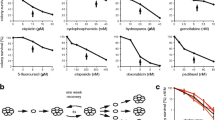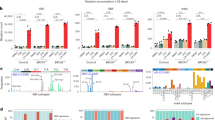Abstract
Mutant cell lines resistant to hydroxyurea (HU), an inhibitor of the enzyme ribonucleotide reductase, were selected from a line of Syrian hamster melanoma cells. Mutant lines were selected for resistance to 0.3 mM HU, and from these lines, second-step mutants were selected for resistance to 1.0 mM HU. The HUr lines were tested for their responses to 5-bromodeoxyuridine (BrdU), in terms of toxicity, mutagenesis, and incorporation of BrdU into DNA. All of the HUr lines showed increased resistance to the toxic effects of BrdU. In addition, the HUr lines all were resistant to BrdU mutagenesis. Overall, there was good correlation among the levels of resistance to HU toxicity, BrdU toxicity, and BrdU mutagenesis in the HUr lines. These tests were carried out under conditions such that the parental and HUr cells incorporated equal amounts of BrdU into nuclear DNA. Therefore, the resistance of the HUr cells to the effects of BrdU cannot be attributed to decreased incorporation of BrdU into DNA. These results suggest that the HUr cells have an alteration in ribonucleotide reductase activity that simultaneously confers resistance to HU and BrdU. The properties of the HUr cells suggest that the perturbation of deoxycytidine metabolism by BrdU triphosphate inhibition of ribonucleotide reductase activity plays a key role in the toxic and mutagenic effects of BrdU in mammalian cells.
Similar content being viewed by others
Literature cited
Bick, M. D., and Davidson, R. L. (1974).Proc. Natl. Acad. Sci. U.S.A. 71:2082–2086.
Kaufman, E. R., and Davidson, R. L. (1978).Proc. Natl Acad. Sci. U.S.A. 75:4982–4986.
Davidson, R. L., and Kaufman, E. R. (1978).Nature 276:722–723.
Kaufman, E. R., and Davidson, R. L. (1979).Somat. Cell Genet. 5:653–663.
Meuth, M., and Green, H. (1974).Cell 2:109–112.
Reichard, P., Cannellakis, Z. N., and Cannellakis, E. S. (1961).J. Biol. Chem. 236:2514–2519.
Moore, E. C., and Huribert, R. B. (1966).J. Biol. Chem. 241:4802–4809.
Horn, D., and Davidson, R. L. (1976).Somat. Cell Genet. 2:469–481.
Kaufman, E. R., and Davidson, R. L. (1978).Somat. Cell Genet. 4:587–601.
Lewis, W., and Wright, J. (1978).J. Cell. Physiol. 97:87–98.
Lewis, W., and Wright, J. (1979).Somat. Cell Genet. 5:83–96.
Moore, G. (1964).Exp. Cell Res. 36:422–423.
Kaufman, E. R., and Davidson, R. L. (1977).Exp. Cell Res. 107:15–24.
Kaufman, E. R., and Davidson, R. L. (1979).Exp. Cell Res., in press.
Author information
Authors and Affiliations
Additional information
This article is dedicated to the memory of Boris Ephrussi-advisor, friend and scientist.
Rights and permissions
About this article
Cite this article
Davidson, R.L., Kaufman, E.R. Resistance to bromodeoxyuridine mutagenesis and toxicity in mammalian cells selected for resistance to hydroxyurea. Somat Cell Mol Genet 5, 873–885 (1979). https://doi.org/10.1007/BF01542647
Received:
Issue Date:
DOI: https://doi.org/10.1007/BF01542647




